This is an old revision of this page, as edited by Magioladitis (talk | contribs) at 06:35, 27 June 2014 (clean up using AWB (10269)). The present address (URL) is a permanent link to this revision, which may differ significantly from the current revision.
Revision as of 06:35, 27 June 2014 by Magioladitis (talk | contribs) (clean up using AWB (10269))(diff) ← Previous revision | Latest revision (diff) | Newer revision → (diff)| This article needs additional citations for verification. Please help improve this article by adding citations to reliable sources. Unsourced material may be challenged and removed. Find sources: "Internal Troops of Russia" – news · newspapers · books · scholar · JSTOR (September 2013) (Learn how and when to remove this message) |
| Internal Troops of the Ministry of Internal Affairs of the Russian Federation Внутренние войска Министерства внутренних дел Vnutrenniye Voiska Ministerstva Vnutrennikh Del | |
|---|---|
 Flag of Internal Troops Flag of Internal Troops | |
| Common name | Internal Troops |
| Agency overview | |
| Formed | March 27, 1811 |
| Employees | 182,000 in 2012 |
| Jurisdictional structure | |
| Federal agency | Russia |
| Operations jurisdiction | Russia |
| Governing body | Ministry of Internal Affairs (Russia) |
| General nature | |
| Operational structure | |
| Headquarters | Moscow |
| Notables | |
| Person |
|
| Anniversary |
|
Internal Troops of the Ministry for Internal Affairs of the Russian Federation) (MVD RF) (Template:Lang-ru; abbreviated ВВ, VV), is a gendarmerie-like paramilitary federal government service in Russia.
Internal Troops support and reinforce the Politsiya, deal with large-scale riots, internal armed conflicts and safeguarding of highly-important facilities (like nuclear power plants). As such, the service has been involved in all conflicts and violent disturbances in modern Russia, including and First and Second Chechen Wars. Internal Troops fall under Armed Forces military command during wartime and fulfill the missions of local defense and rear area security.
Internal Troops consists of both volunteers and conscripts and hence the number of active service members keeps fluctuating. Currently, it has less than 200,000 active members and has shortage of officers since year 1998.Its strength has plunged to this level from the peak strength of 350,000 active members. As May 2013, the commander of the Russian Internal Troops is Army General Nicholas Rogozhin, who was appointed in 2004.
History
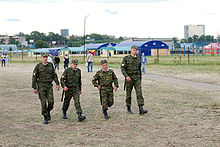
On 28 July 1988, the Presidium of the Supreme Soviet issued a decree “On duties and rights of the Internal Troops of the USSR MVD when safeguarding public order”, clarifying its role in the cracking USSR. However, the Internal Troops were still a part of the Soviet Armed Forces and this state of affairs pleased no one. The Armed Forces did not want to be seen as a force of internal suppression, especially after the disastrous Afghan War. The MVD was finding itself having to extinguish increasingly frequent and violent hot spots and to cope with growing and increasingly well organised and equipped criminals. For this the MVD needed more fire power. On 21 March 1989, the Presidium decided to take the Internal Troops out of the Armed Forces and give them to the Interior Ministry.
Russia treated the First Chechen War as an internal matter and the MVD played a leading role for the Russian forces in the area. However, the VV commanders and servicemen had no experience or training which would prepare them for the conflict. The deputy commander of the Internal Troops General Kavun attempted to justify the less than satisfactory performance of his troops by saying that they had only 39% of the armored vehicles they were allocated on paper.
Legal basis

The Federal Law No.27-173 was signed into law on 6 February 1997. The law sets the operational standards for today's Internal Troops. The law is entitled "On the Russian Federation Ministry of Internal Affairs Internal Troops". When supporting a state-of-emergency regime, Internal Troops are paid salary increases and additional monetary payments according to federal laws and other legal acts approved by the Minister of Internal Affairs. Article 38 grants senior operational commanders the right to call in subunits of special motorized formations and military units outside their deployment areas for a period of up to one month.
The federal law also details the important role that the Russian Ministry of Defense plays in the affairs of the MVD's Internal Troops when crises arise. For example, MOD is responsible for providing airliners for supporting Internal Troop activities during emergency situations, and conditions of armed conflicts; carrying out the stockpiling and echelon armaments and military equipment, ammunition, fuel and supplies for the mobilization deployment of the Internal Troops in wartime; and transferring arms and military equipment free of charge to the Internal Troops through support services based on special decisions of the federal government, and rendering assistance in the repair and restoration of damaged arms and military equipment.
General organization
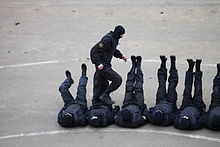
Despite being subordinated to civilian MVD authority, Internal Troops are a paramilitary force with centralized system of ranks, command and service. The Chief Commander and Staff of the troops report only to Ministry of Internal Affairs, maintaining their separate chain of command. VV units in Soviet Union were predominantly formed up of conscripts drafted by the same system as for the Soviet Army. Modern Internal Troops in Russia, as and in Ukraine, have experienced a slow transition to the contract personnel system. VV officers are trained in both own special academies and Army's military academies.
The main kinds of Internal Troops are field units, various facility-guarding units, special motorized units, riot control and patrol units, and special forces like Rus. Since the 1980s, the several spetsnaz (special purpose) units were created within the VV to deal with terrorism and hostage crises. Fields units are essentially light motorized infantry, similar to respective regular army units by their organization and weapons. They and the special forces have been heavily engaged in the armed conflicts in Chechnya and the broader North Caucasus.
Districts and formations

The organization of the Russian Internal Troops comprises headquarters, military units, military training institutions and the institutions for Internal Troops activities, and maintenance and administration bodies. The largest units are located in all major cities.
Internal Troops disctricts:
- Northwestern District
- Moscow Orshansko-Hingansky Order of the Red Banner District
- North Caucasus District
- Privolzhsky District
- Ural District
- Siberian District
- Eastern District
Military units under direct subordination:
- A separate rapid deployment division (ODON). This formation, also known as the Dzerzhinsky Division and based near Moscow, is the most well-known formation of the Internal Troops.
- The Central Communications
- Engineering Center
- Intelligence Directorate Internal Troops under the Intelligence Chief-Deputy Chief of Staff of the Internal Troops.
Missions

- Security - to guard "key" state institutions (except for the Kremlin and the highest echelons of the government which are guarded by the Federal Protective Service (FSO)), nuclear facilities, special storage depots and military bases.
- National defence - to conduct rear area security operations and all military operations within national borders, counter-intelligence authority in wartime.
- Prisoner transport - in Soviet times, also guarded and operated the Gulag camps. Today: convict convoyage and transport. Security and operation of prisons have been performed by the Federal Penitentiary Service since its creation in 1994.
- Public order - to assist the Russian Police for riot control operations when OMON units are not available.
- Border control - to assist the Russian Federal Border Service in the protection of the State border of the Russian Federation.
- Military police functions.
- Counter-terrorist operations (VV special forces units such as Vityaz and Rus).
- Possible counterweight to the regular military, especially during the Soviet era.
Equipment

Internal Troops' equipment includes:
- GAZ-2330 Tigr
- GAZ Vodnik
- BTR-70
- BTR-80
- BTR-90
- BMP-2
- BPM-97
- BRDM-2
- UAZ-469
- Ural-4320
- A wide variety of Soviet- and Russian-made small arms and crew-served weapons.
Shoulder patches
Ministry of Internal Affairs |
Internal Troops of the Ministry of Internal Affairs |
Internal Troops High Command |
 Moscow District |
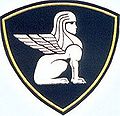 North-West District |
 North Caucasian District |
 Volga District |
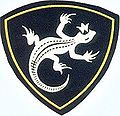 Ural District |
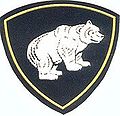 Siberian District |
 Eastern District |
 Internal Security and Military Colleges |
 |
 Management of the Protection of Important Public Facilities and Special Cargo |
See also
References
| This image is available from the United States Library of Congress Prints and Photographs Division under the digital ID {{{id}}} This tag does not indicate the copyright status of the attached work. A normal copyright tag is still required. See Misplaced Pages:Copyrights for more information. |
- Национальная гвардия Владимира Путина — На базе подразделений МЧС, Внутренних войск, ВДВ и военной полиции может появиться новая силовая структура
- Organy I Voyska MVD Rossiiy, MVD Moskva 1996, p461.
- Organy I Voyska MVD Rossiiy, MVD Moskva 1996, p.332
- Rossiyskiye Vooruzhennyye Sily V Chechenskom Konflikte: Analiz, Itogi, Vyvody, N N Novichkov, V Ya Snegovskiy, A G Sokolov, V Yu Shavarov, Kholveg-Infoglob-Trivola, Parizh-Moskva, 1995, p126
- 'Rossiiskaya Federatsiya Federal'ni Zakon o vnutrennikh voiskakh Ministerstva vnutrennikh del Rossiiskoi Federatsii' of 25 December 1996.
- Neil Baumgardner, Russian Armed Forces Order of Battle, see bottom of page.
Further reading
- Galeotti, Mark. "Russia's Interior Troops on the rise." Jane's Intelligence Review 9 (1997): 243-246.
External links
| Law enforcement in Russia | |
|---|---|